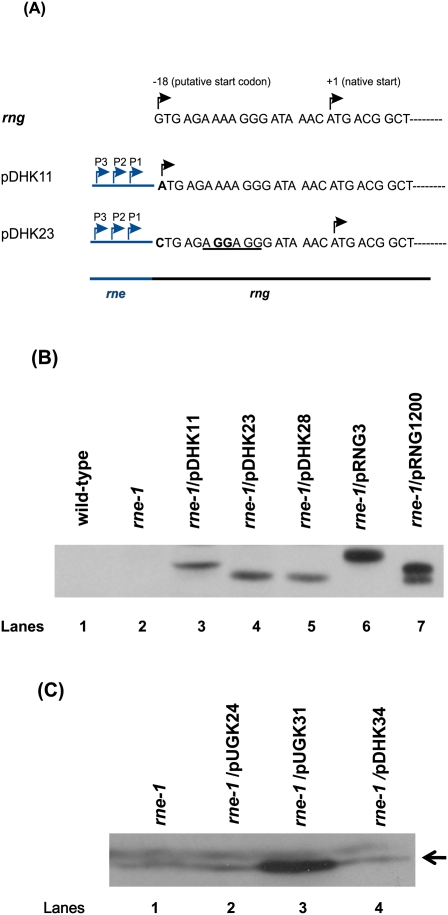FIGURE 1.
(A) Diagrammatic representation of the rng constructs in pDHK11 and pDHK23. The chromosomal rng sequence is shown at the top. The native translation start, identified by sequencing of the protein purified from E. coli (Briant et al. 2003) is shown as +1. The translation start site employed by Lee et al. (2002) and Deana and Belasco (2004) is indicated as −18. The upstream regulatory region of RNase E (shown to the left in blue), including its three promoters, as identified by Ow et al. (2002), was used to express rng in both pDHK11 and pDHK23. In pDHK11, the GTG translation start codon was changed to ATG and the RNase E ribosome binding site was inserted to increase translation efficiency. In pDHK23, the upstream GTG codon was changed to CTG to block potential translation initiation and a canonical ribosome binding site (underlined) was inserted 7 nt upstream of the RNase G native translation start codon (ATG). Altered nucleotides are shown in boldface. Rightward black arrows indicate translation start codons for the two constructs. Rightward blue arrows indicate the transcription start sites associated with the three RNase E promoters. (B) Western blot analysis of RNase G in various strains using 40 μg (lanes 1–5), 20 μg (lane 6), or 2 μg (lane 7) of total cell protein. Lane 1, MG1693; lane 2, SK6610; lane 3, SK3475; lane 4, SK3500; lane 5, SK3540; lane 6, SK5065; and lane 7, SK5067. pDHK11, pRNG3, and pRNG1200 encode an RNase G protein that contains an extra six amino acids at the amino terminus (Fig. 1A). Based on the construction of pRNG1200 (Deana and Belasco 2004), both the native and extended form of the protein will be synthesized (lane 7). pRNG3 (Lee et al. 2002) encodes the extended form of RNase G along with six histidine residues at the carboxy terminus (lane 6). (C) Western blot analysis of RNase G in various strains using 100 μg of total cell protein. Lane 1, SK6610; lane 2, SK2585; lane 3, SK2594; and lane 4, SK3559. The leftward arrow indicates RNase G. The relative quantities (RQ) of RNase G shown in Figure 1B,C are reported in Table 1.

